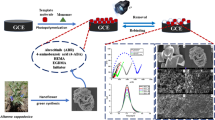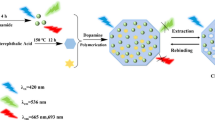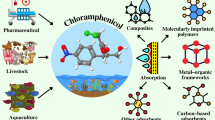Abstract
We aimed to develop a molecularly imprinted polymeric systems with using penicillin G as a template molecule for removal of the antibiotic residues from environmental samples. Firstly, Pen-G-imprinted poly (2-hydroxyethyl methacrylate-N-methacryloyl-l-alanine) [p(HEMA-MAAL)] nanopolymers were synthesized by surfactant-free emulsion polymerization method. Then, template molecule (Pen-G) was extracted from nanopolymers. Synthesized nanopolymers were characterized by different methods such as Fourier-transform infrared spectroscopy (FTIR), elemental and zeta-size analysis, scanning electron microscope (SEM), and surface area calculations. Nanopolymers have 60.38 nm average size and 1034.22 m2/g specific surface area. System parameters on Pen-G adsorption onto Pen-G imprint nanopolymers were investigated at different conditions. The specific adsorption value (Qmax) of molecularly impirinted p(HEMA-MAAL) nanopolymers was found 71.91 g/g for Pen-G in 5 mg/mL Pen-G initial concentration. Pen-G adsorption of molecularly imprinted nanopolymers was 15 times more than non-imprinted polymer. It is shown that obtained p(HEMA-MAAL) nanopolymer was a reuseable product which protected its adsorption capacity of 98.9% after 5th adsorption-desorption cycle. In conclusion, we suggest a method to develop a nanostructure, selective, low-cost molecularly imprinted polymeric systems with using penicillin G as a template molecule for removal of the antibiotic residues.











Similar content being viewed by others
References
Aqda, T. G., Behkami, S., Raoofi, M., & Bagheri, H. (2019). Graphene oxide-starch-based micro-solid phase extraction of antibiotic residues from milk samples. Journal of Chromatography A, 1591, 7–14.
Aktas-Uygun, D., Uygun, M., Altintas, Z., & Akgol, S. (2017). Applications of molecularly imprinted nanostructures in biosensors and medical diagnosis. Biosensors and Nanotechnology: Applications in Health Care Diagnostics.
Ayawei, N., Ebelegi, A. N., & Wankasi, D. (2017). Modelling and interpretation of adsorption isotherms. Journal of Chemistry, 2017, 1–11.
Bangs, L. B. (1989) Uniform latex particles. 41th National meeting. American Association for Clinical Chemistry, Seragen Diagnostics, Indianapolis.
Briscoe, S. E., McWhinney, B. C., Lipman, J., Roberts, J. A., & Ungerer, J. P. J. (2012). A method for determining the free (unbound) concentration of ten beta-lactam antibiotics in human plasma using high performance liquid chromatography with ultraviolet detection. Journal of Chromatography B, 907, 178–184pp.
Bulut, Y., Gözübenli, N., & Aydın, H. (2007). Equilibrium and kinetics studies for adsorption of direct blue 71 from aqueous solution by wheat shells. Journal of Hazardous Materials, 144, 300–306pp.
Cederfur, J., Pei, Y., Zihui, M., & Kempe, M. (2003). Synthesis and screening of a molecularly imprinted polymer library targeted for penicillin G. Journal of Combinatorial Chemistry, 5, 67–72pp.
Congur, G., Senay, H., Turkcan, C., Canavar, E., Erdem, A., & Akgol, S. (2013). Estrone specific molecularly imprinted polymeric nanospheres: Synthesis, characterization and applications for electrochemical sensor development. Combinatorial Chemistry & High Throughput Screening, 16(7), 503–510.
Çorman, M. E., & Akgöl, S. (2012). Preparation of molecular imprinted hydrophobic polymeric nanoparticles having structural memories for lysozyme recognition. Artificial Cells, Blood Substitutes, and Biotechnology, 40(4), 245–255.
Díaz-Bao, M., Barreiro, R., Miranda, J. M., Cepeda, A., & Regal, P. (2015). Fast HPLC-MS/MS method for determining penicillin antibiotics in infant formulas using molecularly imprinted solid-phase extraction. Journal of Analytical Methods in Chemistry, 2015.
Dincer, S., & Yigittekin, E. S. (2017). Spreading of antibiotic resistance with wastewater. Biological Wastewater Treatment and Resource Recovery, 73.
Ertürk, G., & Mattiasson, B. (2016). From imprinting to microcontact imprinting—a new tool to increase selectivity in analytical devices. Journal of Chromatography B, 1021, 30–44.
Fan, H., Wang, J., Meng, Q., Xu, X., Fan, T., & Jin, Z. (2017). Preparation of photoirradiation molecular imprinting polymer for selective separation of branched cyclodextrins. Molecules, 22(2), 288.
Foo, K. Y., & Hameed, B. H. (2010). Insights into the modeling of adsorption isotherm systems. Chemical Engineering Journal, 156(1), 2–10.
Gao, R., Kong, X., Su, F., He, X., Chen, L., & Zhang, Y. (2010). Synthesis and evaluation of molecularly imprinted core–shell carbon nanotubes for the determination of triclosan in environmental water samples. Journal of Chromatography A, 1217(52), 8095–8102.
Garipcan, B., Bereli, N., Pator, S., Arıca, Y., & Denizli, A. (2001). Synthesis of poly[(hydroxyethyl methacrylate)-co-(methacrylamidoalanine)] membranes and their utilization as an affinity sorbent for lysozyme. Macromolecular Bioscience, 1, 332–340pp.
Ghose, S., Hubbard, B. B., & Cramer, S. M. (2005). Protein interactions in hydrophobic charge induction chromatography (HCIC). Biotechnology Progress, 21, 498pp.
Guardia, L., Badía-Laíño, R., Díaz-García, M. E., Ania, C. O., & Parra, J. B. (2008). Role of surface adsorption and porosity features in the molecular recognition ability of imprinted sol–gels. Biosensors and Bioelectronics, 23(7), 1101–1108.
Inanan, T., Tüzmen, N., Akgöl, S., & Denizli, A. (2016). Selective cholesterol adsorption by molecular imprinted polymeric nanospheres and application to GIMS. International Journal of Biological Macromolecules, 92, 451–460.
Instruments, M. (2004). Zetasizer nano series user manual. MAN0317, 1, 2004.
Inyinbor, A. A., Adekola, F. A., & Olatunji, G. A. (2016). Kinetics, isotherms and thermodynamic modeling of liquid phase adsorption of Rhodamine B dye onto Raphia hookerie fruit epicarp. Water Resources and Industry, 15, 14–27.
Jalili, R., Khataee, A., Rashidi, M. R., & Razmjou, A. (2020). Detection of penicillin G residues in milk based on dual-emission carbon dots and molecularly imprinted polymers. Food Chemistry, 126172.
Javanbakht, M., Pishro, K.A., Nasab, A.M., Akbari-adergani, B. (2012). Extraction and purification of penicillin G from fermentation broth by water-compatible molecularly imprinted polymers. Materials Science and Engineering C, 32:2367–2373pp
Joshi, S. (2002). HPLC separation of antibiotics present in formulated and unformulated samples. Journal of Pharmaceutical and Biomedical Analysis, 28(5), 795–809.
Kamranifar, M., Allahresani, A., & Naghizadeh, A. (2019). Synthesis and characterizations of a novel CoFe2O4@ CuS magnetic nanocomposite and investigation of its efficiency for photocatalytic degradation of penicillin G antibiotic in simulated wastewater. Journal of Hazardous Materials, 366, 545–555.
Karaseva, N., Ermolaeva, T., & Mizaikoff, B. (2016). Piezoelectric sensors using molecularly imprinted nanospheres for the detection of antibiotics. Sensors and Actuators B: Chemical, 225, 199–208.
Koch, C., Poghossian, A., Schöning, M. J., & Wege, C. (2018). Penicillin detection by tobacco mosaic virus-assisted colorimetric biosensors. Nanotheranostics, 2(2), 184–196.
Kraemer, S. A., Ramachandran, A., & Perron, G. G. (2019). Antibiotic pollution in the environment: from microbial ecology to public policy. Microorganisms, 7(6), 180.
Kuru, C. İ., Türkcan, C., Uygun, M., Okutucu, B., & Akgöl, S. (2014). Preparation and characterization of silanized poly(HEMA) nanopolymers for recognition of sugars. Artificial Cells, Nanomedicine, and Biotechnology, 44, 835–841.
Lata, K., Sharma, R., Naik, L., Rajput, Y. S., & Mann, B. (2015). Synthesis and application of cephalexin imprinted polymer for solid phase extraction in milk. Food Chemistry, 184, 176–182.
Lingzhi, L., Haojie, G., Dan, G., Hongmei, M., Yang, L., Mengdie, J., Chengkun, Z., & Xiaohui, Z. (2018). The role of two-component regulatory system in β-lactam antibiotics resistance. Microbiological Research, 215, 126–129.
Lobanovska, M., & Pilla, G. (2017). Focus: Drug development: Penicillin’s discovery and antibiotic resistance: Lessons for the future? The Yale Journal of Biology and Medicine, 90(1), 135.
Luo, Z., Du, W., Zheng, P., Guo, P., Wu, N., Tang, W., et al. (2015). Molecularly imprinted polymer cartridges coupled to liquid chromatography for simple and selective analysis of penicilloic acid and penilloic acid in milk by matrix solid-phase dispersion. Food and Chemical Toxicology, 83, 164–173.
Luo, Z., Zeng, A., Zheng, P., Guo, P., Du, W., Du, K., & Fu, Q. (2014). Preparation of surface molecularly imprinted polymers as the solid-phase extraction sorbents for the specific recognition of penicilloic acid in penicillin. Analytical Methods, 6(19), 7865–7874.
Malkoç, E. (2006). Ni(II) removal from aqueous solutions using cone biomass of Thuja orientalis. Journal of Hazardous Materials, 137, 899–908pp.
Mohsenzadeh, M. S., Mohammadinejad, A., & Mohajeri, S. A. (2018). Simple and selective analysis of different antibiotics in milk using molecularly imprinted polymers: a review. Food Additives & Contaminants: Part A, 1–16.
Moreno-González, D., Rodríguez-Ramírez, R., del Olmo-Iruela, M., & García-Campaña, A. M. (2017). Validation of a new method based on salting-out assisted liquid-liquid extraction and UHPLC-MS/MS for the determination of betalactam antibiotics in infant dairy products. Talanta, 167, 493–498.
Ncube, S., Madikizela, L. M., Nindi, M. M., & Chimuka, L. (2019). Solid phase extraction technique as a general field of application of molecularly imprinted polymer materials. Mip synthesis, characteristics and analytical application, 41.
Okocha, R. C., Olatoye, I. O., & Adedeji, O. B. (2018). Food safety impacts of antimicrobial use and their residues in aquaculture. Public Health Reviews, 39(1), 1–22.
Olcer, Y. A., Demirkurt, M., Demir, M. M., & Eroglu, A. E. (2017). Development of molecularly imprinted polymers (MIPs) as a solid phase extraction (SPE) sorbent for the determination of ibuprofen in water. RSC Advances, 7(50), 31441–31447.
Paulino, A. T., Minasse, F. A. S., Guilherme, M. R., Reis, A. V., Muniz, E. C., & Nozaki, J. (2006). Novel adsorbent based on silkworm chrysalides for removal of heavy metals from wastewaters. Journal of Colloid and Interface Science, 301, 479–487pp.
Pinder, N., Brenner, T., Swoboda, S., Weigand, M. A., & Hoppe-Tichy, T. (2017). Therapeutic drug monitoring of beta-lactam antibiotics–influence of sample stability on the analysis of piperacillin, meropenem, ceftazidime and flucloxacillin by HPLC-UV. Journal of Pharmaceutical and Biomedical Analysis, 143, 86–93.
Pupin, R. R., Foguel, M. V., Gonçalves, L. M., & Sotomayor, M. D. P. T. (2020). Magnetic molecularly imprinted polymers obtained by photopolymerization for selective recognition of penicillin G. Journal of Applied Polymer Science, 137(13), 48496.
Quesada-Molina, C., Claude, B., García-Campaña, A. M., del Olmo-Iruela, M., & Morin, P. (2012). Convenient solid phase extraction of cephalosporins in milk using a molecularly imprinted polymer. Food Chemistry, 135(2), 775–779.
Refaat, D., Aggour, M. G., Farghali, A. A., Mahajan, R., Wiklander, J. G., Nicholls, I. A., & Piletsky, S. A. (2019). Strategies for molecular imprinting and the evolution of MIP nanoparticles as plastic antibodies—synthesis and applications. International Journal of Molecular Sciences, 20(24), 6304.
Safari, M., Shamsipur, M., Zohrabi, P., & Ebrahimzadeh, H. (2019). Solid-phase extraction combined with dispersive liquid-liquid microextraction/HPLC-UV as a sensitive and efficient method for extraction, pre-concentration and simultaneous determination of antiretroviral drugs nevirapine, efavirenz and nelfinavir in pharmaceutical formulations and biological samples. Journal of Pharmaceutical and Biomedical Analysis, 166, 95–104.
Samanidou, V., Michaelidou, K., Kabir, A., & Furton, K. G. (2017). Fabric phase sorptive extraction of selected penicillin antibiotic residues from intact milk followed by high performance liquid chromatography with diode array detection. Food Chemistry, 224, 131–138.
Soledad-Rodriguez, B., Fernandez-Hernando, P., Garcinuno-Martinez, R. M., & Durand-Alegria, J. S. (2017). Effective determination of ampicillin in cow milk using a molecularly imprinted polymer as sorbent for sample preconcentration. Food Chemistry, 224, 432–438.
Turiel, E., & Martín-Esteban, A. (2019). Molecularly imprinted polymers-based microextraction techniques. TrAC, Trends in Analytical Chemistry, 118, 574–586.
Turiel, E., & Esteban, A. M. (2020). Molecularly imprinted polymers. In Solid-phase extraction (pp. 215-233). Elsevier.
Türkmen, D., Bereli, N., Çorman, M. E., Shaikh, H., Akgöl, S., & Denizli, A. (2014). Molecular imprinted magnetic nanoparticles for controlled delivery of mitomycin C. Artificial Cells, Nanomedicine, and Biotechnology, 42(5), 316–322.
Urraca, J. L., Moreno-Bondi, M. C., Hall, A. J., & Sellergren, B. (2007). Direct extraction of penicillin G and derivatives from aqueous samples using a Stoichiometrically imprinted polymer. Analytical Chemistry, 79, 695–701pp.
Weber, P., Riegger, B. R., Niedergall, K., Tovar, G. E., Bach, M., & Gauglitz, G. (2018). Nano-MIP based sensor for penicillin G: Sensitive layer and analytical validation. Sensors and Actuators B: Chemical, 267, 26–33.
Willms, I. M., Yuan, J., Penone, C., Goldmann, K., Vogt, J., Wubet, T., Schöning, I., Schrumpf, M., Buscot, F., & Nacke, H. (2020). Distribution of medically relevant antibiotic resistance genes and Mobile genetic elements in soils of temperate forests and grasslands varying in land use. Genes, 11(2), 150.
Wu, N., Luo, Z., Ge, Y., Guo, P., Du, K., Tang, W., et al. (2016). A novel surface molecularly imprinted polymer as the solid-phase extraction adsorbent for the selective determination of ampicillin sodium in milk and blood samples. Journal of Pharmaceutical Analysis, 6(3), 157–164.
Yin, J., Meng, Z., Du, M., Liu, C., Song, M., & Wang, H. (2010). Pseudo-template molecularly imprinted polymer for selective screening of trace β-lactam antibiotics in river and tap water. Journal of Chromatography. A, 33, 5420–5426pp.
Zhang, J., Wang, H., Liu, W., Bai, L., Ma, N., & Lu, J. (2008). Synthesis of molecularly imprinted polymer for sensitive penicillin determination in milk. Analytical Letters, 41(18), 3411–3419.
Zhang, X., Chen, L., Xu, Y., Wang, H., Zeng, Q., Zhao, Q., Ren, N., & Ding, N. (2010). Determination of β-lactam antibiotics in milk based on magnetic molecularly imprinted polymer extraction coupled with liquid chromatography–tandem mass spectrometry. Journal of Chromatography B, 878, 3421–3426pp.
Zhu, G., Cheng, G., Wang, P., Li, W., Wang, Y., & Fan, J. (2019). Water compatible imprinted polymer prepared in water for selective solid phase extraction and determination of ciprofloxacin in real samples. Talanta, 200, 307–315.
Acknowledgments
This study was performed with financial support from Ege University Scientific Research Project Coordination (Project no.12/FEN/029).
Author information
Authors and Affiliations
Corresponding author
Additional information
Publisher’s note
Springer Nature remains neutral with regard to jurisdictional claims in published maps and institutional affiliations.
Electronic supplementary material
ESM 1
(DOCX 22 kb)
Rights and permissions
About this article
Cite this article
Kuru, C.I., Ulucan, F., Kuşat, K. et al. A model study by using polymeric molecular imprinting nanomaterials for removal of penicillin G. Environ Monit Assess 192, 367 (2020). https://doi.org/10.1007/s10661-020-08294-2
Received:
Accepted:
Published:
DOI: https://doi.org/10.1007/s10661-020-08294-2




